The Restaurant With The Cruise Ship Out Front
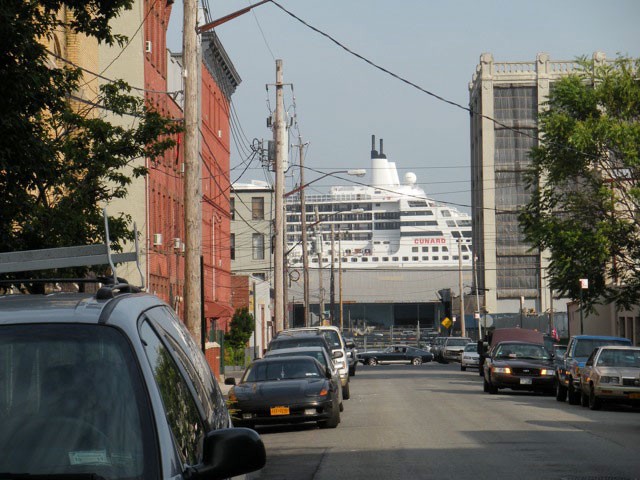
If the three most important things about opening a new business are location, location, location, then the location that brought Philly Pinoy, a new Brooklyn restaurant, into being is the Brooklyn Cruise Terminal, where a couple of cruise liners pick up and discharge passengers headed for the Caribbean or a trans-Atlantic passage. Sit at one of the tables arrayed on the sidewalk in front of Philly Pinoy, you can look down the street and see the ship in port. If it’s the Queen Mary 2, she’s hard to miss, as she is as big as a skyscraper lying on her side. Philly Pinoy is both out of place and totally in its element in this corner of Brooklyn; another piece of patchwork in the quilt, like the corrugated cardboard company, like the depots for the Chinatown buses, like Central American food tents at the soccer fields, like Defonte’s Sandwich Shop.
Philly Pinoy’s offerings would seem a honey trap for foodies — Filipino dishes unfamiliar to the American palate, like ginisand ampalaya, a sautéed bitter melon, and bopis, a spicy concoction of offal that would not be out of place at some nose-to-tail joint a neighborhood over. But it’s not the foodies that eat at Philly Pinoy, and it’s not the vacationers; it’s the crews from the ships.
On the two lines that use the Terminal, Cunard and Princess, a good portion of crew members (the deck crew, the engine crew, the kitchen workers, the maids, etc.) are Filipino. It’s a fact of the global economy and the economic migration that comes with it, that one of the countries that’s strong in the market in providing the modern equivalent of sailors is the Philippines. As the Philippines is rarely a port-of-call for these ships, they are eager to have some connect with the foods and groceries of their home nation, even if in the context of a cruise terminal parking lot, or a storefront a half-block away.
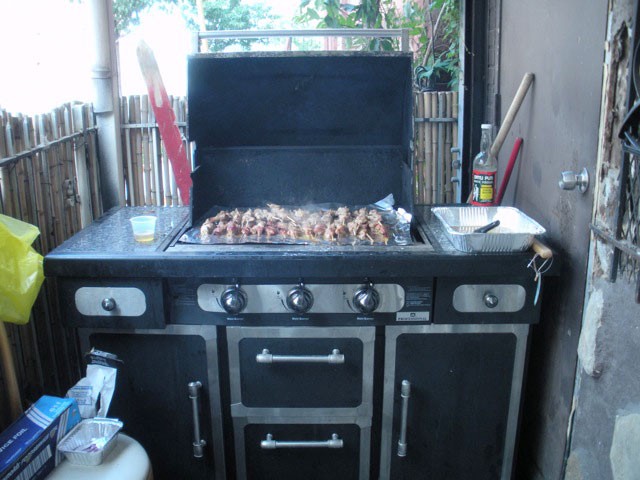
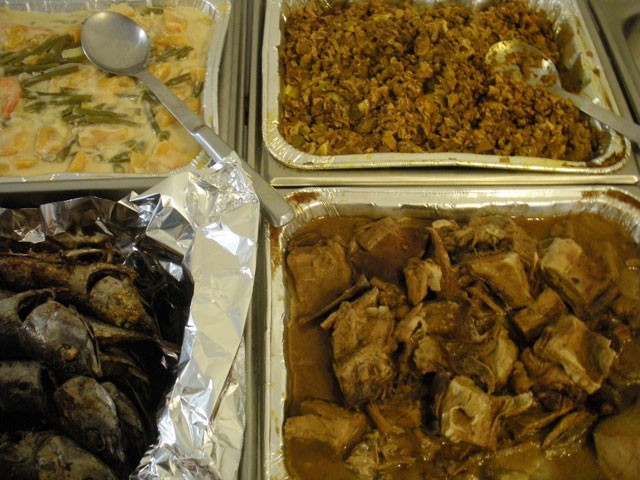
Philly Pinoy is located on Pioneer Street, between Van Brunt Street and Imlay Street in Red Hook, a humble little nub of Brooklyn. It’s nearly a peninsula, famously cut off from the rest of the world by the Gowanus Canal, by the BQE overpass and by Buttermilk Channel. The closest subway is a very stiff walk away. It’s a mixed use neighborhood — in addition to the acres given to the Terminal, there are large swaths of industry, equally large swaths of public housing, and small islands of single-family homes and apartments. The residential areas largely sprout off the spine of Van Brunt Street, which runs parallel to the Channel to the northwest and terminates at the end of the neighborhood, overlooking Gowanus Bay and beyond it New York Harbor. Down that way, maybe at Louis Valentino Jr. Park or even on the grounds of the Ikea recently built, you can get a pretty awesome view out towards Staten Island and the ports of New Jersey.
The locals of Red Hook are a tight bunch, not afraid to organize for the community and the good of the neighborhood in general. They’ve been lobbying for the reinstatement of a trolley that would connect them to the rest of the city for generations, and the recent development of the Brooklyn Terminal and the Ikea were met with a decided resistance. And in the middle of this, largely unnoticed, is Philly Pinoy, across the street from a trucking concern.
The owner, Benjamin David, is a friendly guy, with a smile that’s quick and a handshake that’s eager. I met him there on a Saturday morning, early. It was a one-man operation on that day, but he took a couple of minutes out of prep to chat, with the morning rush of early diners only two hours away. When he realized that he left the rice cooker in the van, I decided that I should hit the road so that he could get on with it. He looks you in the eye when he talks. He’s hard not to like.
David is an inadvertent element of the patchwork quilt of Red Hook. He knew that the Filipinos on board would come because he himself was a waiter on the Cunard line, from 1988 to 1992. “I thought of this idea,” David explained. “Why don’t I sell to cruise ships that come in? It’s really hard to find that stuff when you’re working on one.” He’s from India, and he landed in the States after his stint a-sea. Until recently, he was with TJ Maxx in Philadelphia. He lost that job, and he became just another member of the growing ranks of the downsized.
But then David, his brother, Hyen, and Hyen’s wife, Rowena, a native-born Filipino, saw an opportunity in the Pinoy population in the area, and opened a grocery that would sell Filipino groceries and also food prepared by Rowena. A catering business followed, and then the incursion into Brooklyn: David started selling Filipino food and packaged snacks out of the back of his car in the parking lot of the Terminal, until his car was too small, so he bought a van. Then he kept an eye out for a store, something small and close to the Terminal, both of which Philly Pinoy is, with racks of Filipino snack foods lining the walls, and seating outside on tables and chairs. The food is cooked by Rowena and loaded into chafing dishes and then driven up by David in the morning. On the days the ships put in (every week and a half, or so), the crews start streaming down Pioneer a little bit after nine in the morning, and they’re back on the ship by three, when the ship embarks.
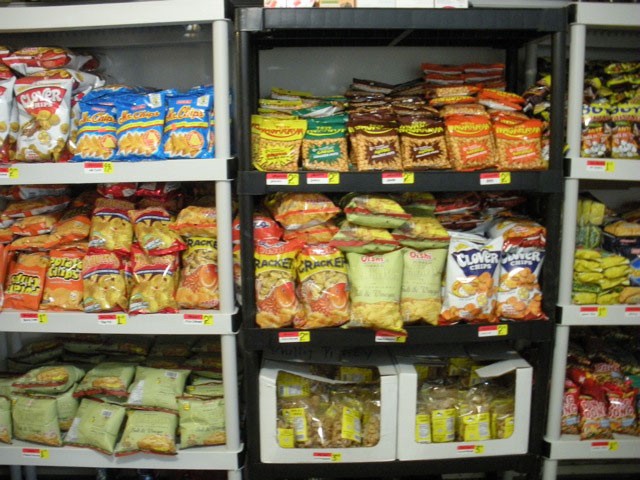
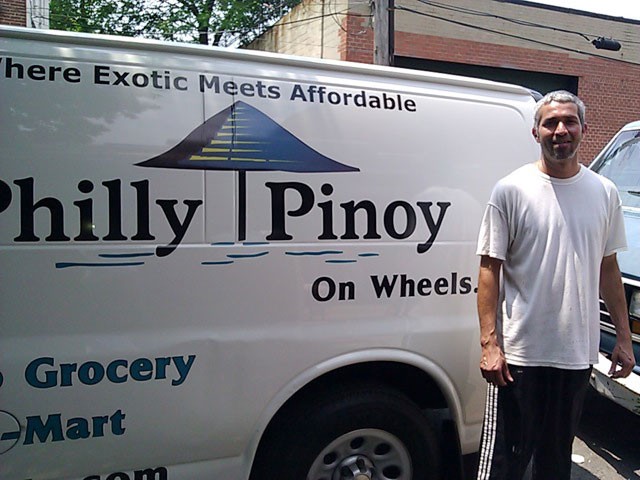
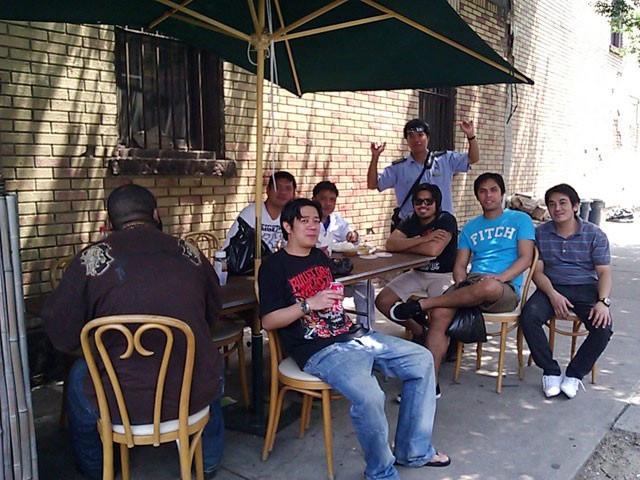
This is not so much of a case of gentrification by ethnic restaurant. Philly Pinoy is not part of a wave of immigrants taking advantage of cheap storefront space, and Filipino cuisine is not one of the cuisines like Chinese, Mexican and Thai that traditionally gain footholds and then propagates. This is more of a bootstrap story, of finding opportunity in the negative spaces.
David, without necessarily planning to, is combining two elements of the for-some-reason foodie industry thriving in New York City. The landscape currently, aside from the farm-to-table and the microceleb chefs, features pop-up restaurants and food-truck footholds. Both trends are reactions to the overwhelming costs of opening a restaurant — the cost of design and construction, the liquor license, the business plan, and generally the cash-flow chasm between the time when the restaurateur starts working on the start-up and starts taking money from customer. Pop-ups, opening in temporary spaces with ad hoc kitchens, slash the costs significantly, while the food trucks, intended to result in a brick and mortar joint eventually, stretch out the cash outlays and provide for a steady stream of income during the process.
Philly Pinoy is fully occupying both of these trends, but without a publicist or a Twitter account. David is not following his dream in the traditional sense that would be more at home as a subject for programming on one of the food channels. “I never saw myself opening a restaurant,” David said. He identified a market of people that wanted to be fed, and feeds them. And the slow ramp-up into full service is necessity and not shrewdness.
And as of June 6, David is going for it, keeping Philly Pinoy open for regular hours five days a week, cruise ship at port or no, offering some more familiar fare like burgers and hots, and some Philadelphia water ice. I asked him how the first week went, and he grimaced, and said that there was not so much business, that some of the guys that work in warehouses nearby came in. Hopefully the cool-hunting gastrohipster community of the greater metropolitan area might give him a boost. But the business is precarious. While starting a place is not easy, keeping it open for a year, or five or ten, makes a start-up look like a cakewalk in the park. There’s no guarantee for David. He hopes that the community nestled around neighborhood haunts like Baked and the Good Fork discovers him and gives him some business, but Philly Pinoy may not even be there in a month or two.
It’s a novel endeavor, though — a snapshot that captures how things work outside of the spotlight now: an Indian immigrant, recently loosed from a good job for a big company, decides to get a toe-hold in a business he’s not used to, selling his sister-in-law’s food in a city in which he does not live, and gives it a go from there, away from the food blogs, away from the well-heeled diners. The world is getting smaller in unexpected ways, as bits of elsewhere pop up in the shadows and the crannies, replicating the blueprints of success that garner the bright lights of the headlines.
Brent Cox is all over the Internet.
Photos of Benjamin David in front of his van and customers (crew members from the Queen Mary 2) in front of the restaurant are by Tina Fallon.
